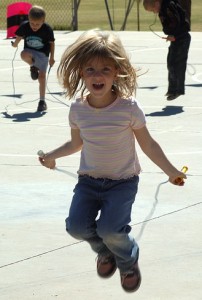In the beginning though setting our goals and our frame of mind for reaching them is the first hurdle that can make all the difference in the world. Maybe you have heard of the S.M.A.R.T. way of goal setting but this would be a good time to review this goal setting technique and how to use it with our children of any age.
S is for being Specific. For a goal to be specific it must answer the basic questions of Who, What, Where, When and How. If you can add Why to the list it makes for a much stronger case for sticking with the goal.
M is for Measurable. What will be the concrete evidence that you attained your goal? When you can answer that you have the measurable part covered.
A is for Attainable. Almost all goals are attainable with planning and with a positive attitude. While a goal may seem far fetched in our eyes at first, believing that you are capable and then breaking down the steps to achieving your goal into smaller increments and working on them step by step on a daily basis will help you to reach your goal.
R is for Realistic. Now there are two ways of approaching this requirement. One is to set the bar low, but in so doing we are not pushing our limits and the motivation for completion may be low. However setting the bar high, allows our creative juices to flow, our motivation to be high, and our desire to be strong. The only question is if we believe in ourselves to continue on the path or will we give up for lack of perseverance.
T is for Timely. Having a time frame for completion is critical for us to staying focused. There is never a chance for us to reach our goal on ‘Someday’. It never comes and we are not serious yet about reaching that goal nor do we see the urgency to do so.
How does all this apply to helping our children? If we start with our young children and teach them the S.M.A.R.T. way of setting goals we will be able to support them to persevere to accomplishment and then of course celebrate with them the planning, effort and accomplishment. Here is an example:
 Your child wants to learn to jump rope. The goal is to be able to jump rope in continuously without stopping.
Your child wants to learn to jump rope. The goal is to be able to jump rope in continuously without stopping.
Measurable: My goal is to be able to jump 100 times in a row without missing.
Attainable: I know this can be done, because I have seen some older kids able to jump rope for 3-4 minutes. To reach my goal I will devote at least 10 minutes every day to practice. I will start with 10 jumps in a row and add 1 jump everyday until my birthday. That way I will be able to do 100 jumps by that time.
Realistic: I believe that if I can jump rope 100 times, I will be able to jump for a whole minute straight through. That would make me very proud of my accomplishment and I will ask for pledges for 1 minute of jumping rope from friends and neighbors.
Timely: If I start today with 10 minutes of practice I will be able to complete my goal in time for the fundraiser.
Helping our children to break their goals down into small steps, telling others about our goals and hopes, and then committing to the completion of the steps on a daily basis will teach our children not only how to set goals, but the rewards of hard work, effort and perseverance. As parents celebrate the small victories, do not get frustrated and demonstrate a belief in your child’s ability to reach their goal if they put forth the effort, stick to their plan and persevere.
By the way, Balanced Life Skills has taught hundreds of children to jump rope just this way. Here is one example when one of our students reached 15 jumps in a row! Just today Austin reached a new goal of 30 seconds of jumping without missing. Congratulations! We can help your child to do the same with goals they want to reach.

